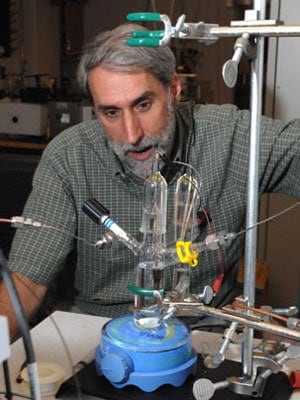In the quest for sustainable energy solutions, the concept of artificial leaves emerges as a compelling innovation that mimics the natural processes of photosynthesis. These synthetic structures promise to transform sunlight, water, and carbon dioxide into usable fuel, echoing the botanical alchemy performed by nature’s verdant entities. Like their natural counterparts, artificial leaves are poised to become pivotal players in the global movement toward renewable energy, yet they carry a distinct allure—an advanced synthesis of biology and technology that intrigues scientists and laypersons alike.
The foundational principle of artificial leaves lies in the replication of photosynthesis, a biochemical process whereby green plants convert light energy into chemical energy, stored in carbohydrates. Scientists have painstakingly engineered components that can harness solar energy and convert it into chemical fuels such as hydrogen or methane. This endeavor not only echoes the elegance of natural processes but also underscores a profound synergy between nature and technology. By bridging these domains, artificial leaves symbolize a futuristic paradigm—one where human ingenuity collaborates with environmental systems to address pressing energy challenges.
At the heart of these innovations are semiconductor materials designed to absorb sunlight efficiently. Once the light is captured, various catalytic processes enable the conversion of water and carbon dioxide into fuel. These processes, often orchestrated by specialized catalysts, can be finely tuned to optimize efficiency and output, similar to a maestro conducting a symphonic arrangement. In this metaphorical orchestra, sunlight serves as the conductor, guiding the performers—the catalysts, and the reactants—toward a harmonious conclusion: the generation of energy.
The allure of artificial leaves extends beyond their functional capabilities. They represent a tangible response to the increasing urgency surrounding climate change, fossil fuel depletion, and energy crises. As global energy demands soar alongside the ever-dwindling reserves of non-renewable resources, the deployment of artificial leaves stands as a beacon of hope, illuminating pathways toward a future where energy is abundant, clean, and readily available. They are akin to modern-day alchemists, poised to turn the elemental gifts of the earth—sunlight, water, and air—into sustainable energy. With such potential, artificial leaves invite a reassessment of the realities of renewable energy, urging us to envision a world where fuel can be ‘grown’ rather than extracted.
One salient advantage of artificial leaves is their versatility in location and application. Unlike traditional solar panels, which are constrained by physical configurations and geographical limitations, artificial leaves can potentially be deployed in a myriad of environments—from urban rooftops to remote, uninhabitable landscapes. This adaptability is pivotal in scenarios where land for conventional solar farms is limited or where infrastructure for energy distribution is lacking. Herein lies a metaphorical parallel to nature: just as leaves adapt to their surroundings, artificially engineered counterparts can proliferate across diverse terrains, making them an invaluable tool in the global arsenal against energy scarcity.
Another noteworthy dimension of this technology is its comparative efficiency. While solar panels primarily convert sunlight into electrical energy, artificial leaves can directly produce chemical fuels, offering an alternative energy vector. Chemical fuels can be more easily stored and transported than electricity, facilitating their integration into existing energy infrastructures. The transition from electrical energy to chemical energy echoes the ancient practice of fire—the fundamental energy source for humanity, rekindled in a new form. As civilizations have historically relied on fire for survival and development, artificial leaves rekindle the essence of that relationship with energy, albeit through a modern lens of technological advancement.
However, despite the promise and prospects offered by artificial leaves, there are considerable challenges that must be addressed to bring this technology to fruition. The efficiency of light capture, the stability of the materials used, and the overall economic viability of large-scale production pose significant hurdles. It is essential to not romanticize the journey; scientific progress often encounters setbacks and requires persistent refinement. Each barrier presents an opportunity for further inquiry and innovation, reinforcing the notion that this field is still in its nascent stages. As researchers continue to unravel the complexities of catalyst design and process optimization, the potential for breakthrough discoveries remains high.
The interconnectedness of artificial leaves with broader energy systems must also be addressed. Integration with existing energy grids and consideration of energy policies will play crucial roles in determining the feasibility of widespread adoption. Artificial leaves must navigate the intricate web of socio-economic factors that govern energy consumption; successful deployment will require collaboration between scientists, policymakers, and industry stakeholders. Through concerted effort, gaps can be bridged, and pathways can be constructed to harness the transformative potential of this technology.
In conclusion, artificial leaves represent a revolutionary fusion of natural processes and cutting-edge technology, encapsulating humanity’s enduring quest for sustainable and clean energy. They stand poised to challenge conventional energy paradigms and offer a glimpse into an energy future markedly distinct from the one dictated by fossil fuels. As innovation continues to fortify the principles behind these synthetic leaves, society is invited to envision a new era of energy generation—one where humanity, akin to nature, learns to cultivate energy rather than merely extract it. It is a prospective future where artificial leaves flourish—not merely as scientific marvels but as integral components of a sustainable world.












